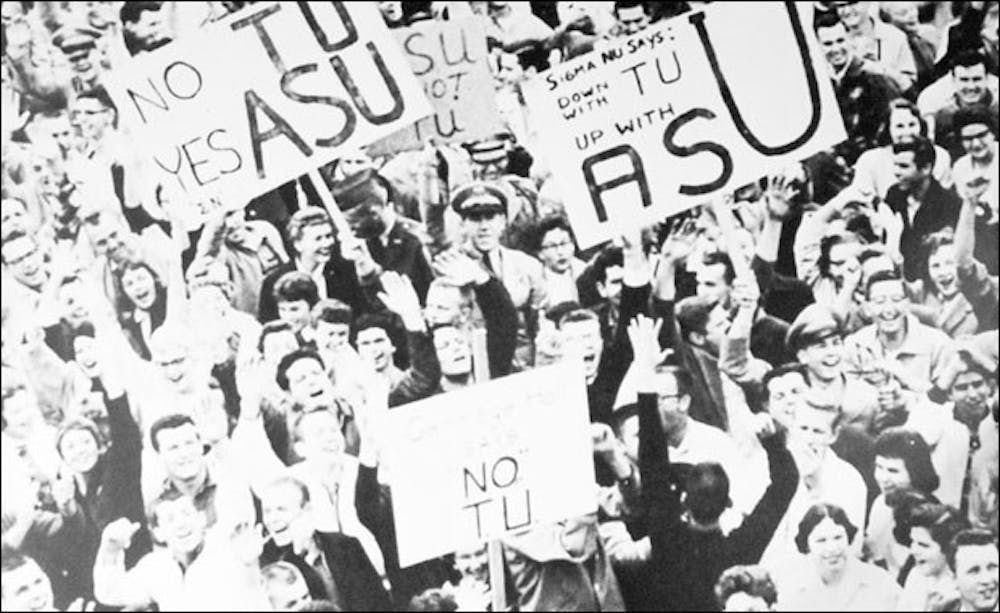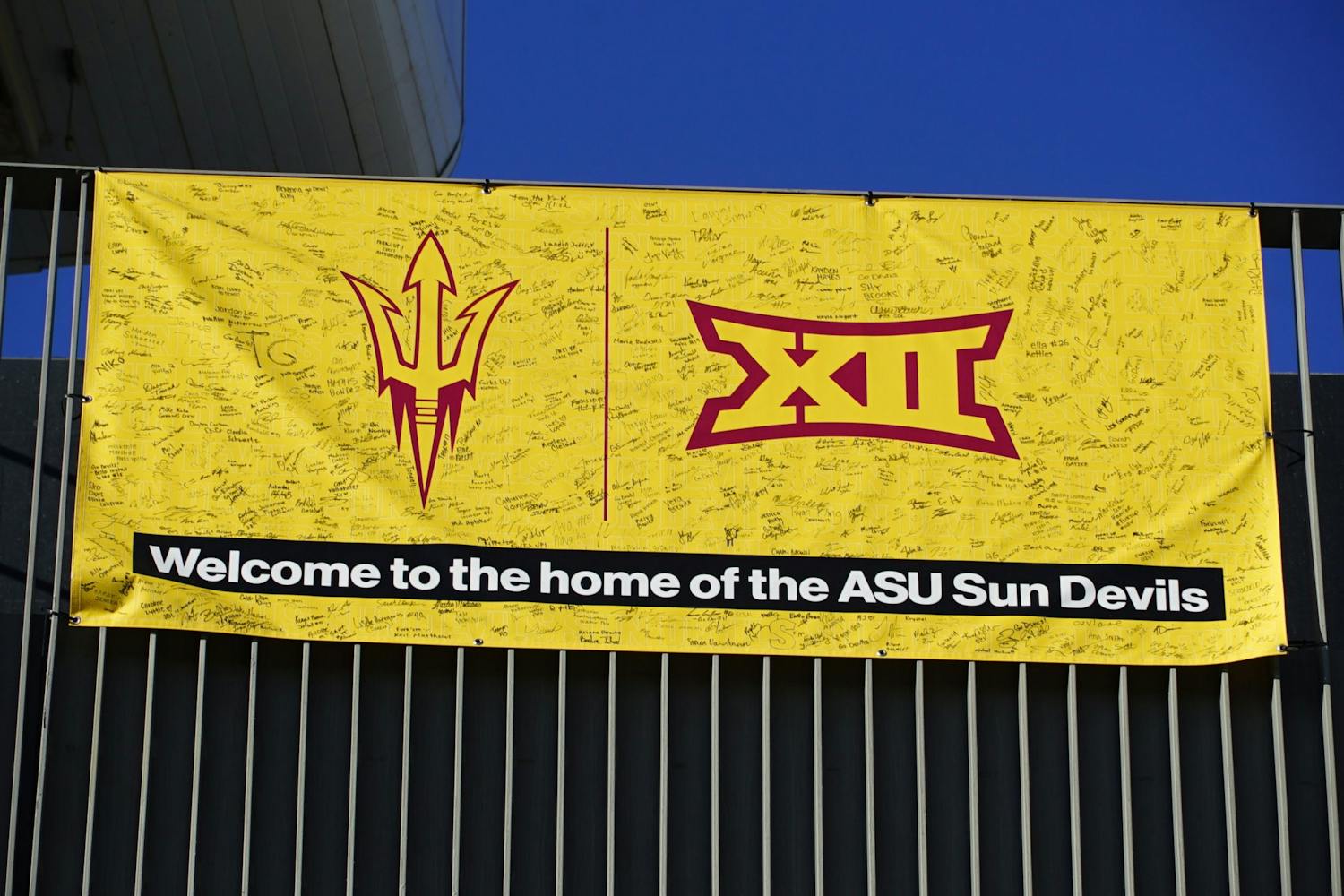 Students rally to change the name of Arizona State College to Arizona State University in 1958. (University Archives Photograph/ASU Archives)
Students rally to change the name of Arizona State College to Arizona State University in 1958. (University Archives Photograph/ASU Archives)As Arizonans journey to cast their presidential votes Tuesday, many of Arizona’s older residents remember the day they voted to turn Arizona State from a college into a university.
Tuesday marks the 50th anniversary of Election Day in 1958, the year Arizona State College at Tempe became Arizona State University in a groundbreaking public vote.
ASU’s case is unique: It is the only school in the country that gained its university classification in a statewide election.
Grady Gammage Jr., 56, son of then ASU President Grady Gammage, said most universities come into being by passive action, the opposite of the fight ASU required.
“Here it was a knock-down, drag-out battle,” he said. “A direct populist uprising by the people of Arizona.”
ASC’s enrollment boomed in the years following World War II after Democratic U.S. Sen. Ernest McFarland of Arizona created the G.I. Bill of 1944, an act that provided for college education for veterans returning from the war.
As a result of the bill, there was a 110 percent increase in the student body between 1945 and 1946, according to ASU’s 2008 Annual Report.
Due to a rapidly expanding student body, the Arizona Board of Regents called for the U.S. Department of Education to evaluate the school in 1953.
Historically a teachers’ college, ASC was reorganized and established four new formal colleges: liberal arts, education, applied arts and sciences, and business and public administration.
Under the guidance of longtime president Grady Gammage, who led the school from 1933 to 1959, Arizona State began functioning as a university without being recognized as such.
By the 1950s, the college offered a number of bachelor’s degrees and had offered a master’s in education since 1937.
Gammage solicited a name change but was denied by a Legislature and Board of Regents largely operated by UA graduates.
“My father decided that his career was staked in ASU,” Gammage said.
“He went to the UA. He worked in Flagstaff [at Arizona State Teacher’s College, now NAU]. But he decided that because Phoenix was where the growth was taking place, there had better be a great university in the main city.
“He was going to stay here and make that happen,” Gammage said.
Harold Giss, then a Democratic state senator from Yuma, watched the conflict and promised Gammage he would create legislation to name ASC a university.
Giss did, but the proposed name wasn’t what anyone, including Gammage, expected: Tempe University.
The student body rejected the proposal, longing for a name that promoted the growing state college they attended.
During the 1958 spring semester, outraged students, faculty and administration began to fight back.
On March 4, about 2,000 students protested across campus and hundreds of demonstrators continued on to the State Capitol seeking change.
Petitions emerged, and a campaign to put the proposition of a name change to public vote began.
Throughout the next months, students fervently petitioned and rallied for the change.
James Creasman, who was then the Alumni Association director, organized a collegewide effort to take the name change to the Arizona ballot.
Don Dotts, a 1957 graduate and former Alumni Association director, worked under Creasman during the campaign.
“President Gammage told Jimmy [Creasman], ‘OK, if we’re going to have a campaign, we had better win it,’” Dotts said.
Exactly 28,859 valid signatures were needed for the proposition to be placed on the ballot. Almost 600 students collected 63,956 signatures from across the state, and Proposition 200 came to life.
Students delivered the signatures to the Capitol in an armored car, Dotts said.
“It may have been overkill, but the students were extremely passionate about what they had accomplished,” he said.
The proposal immediately secured a spot on the 1958 ballot.
Faculty and staff members — including the president’s wife Kathryn Gammage and first-year football coach Frank Kush — toured the state to encourage and inform voters to endorse the change.
Grady Gammage Jr., 6 years old at the time, said he traveled with his mother all over Arizona to promote the ballot measure.
“There was a lot of tension in the house during regents meetings early on,” Gammage said. “But once the campaign started, my parents became extremely focused on the goal.”
Former NAU secretary Bernadene Gardiner, 80, was living in Tucson during the 1958 election season.
“People here were ballistically against the idea,” she said. They generally carried the sentiment that UA should be the only university in Arizona, she said.
On the night of Nov. 4, 1958, students congregated in the two-year-old Memorial Union to learn the results of the election.
The crowd, expecting a win, was shaken when an early wire-service report mistakenly indicated the proposition was losing, Dotts said.
But the anxious crowd learned at 11 p.m. that the name change prevailed. The proposition carried every county except for Yuma and Pima.
Elation and pride in the results took thousands of students to the mall outside of the MU where Gammage jubilantly addressed the crowd.
The change was a defining moment in his 27-year career at the institution.
“There had always been an ‘A’ on the mountain,” Dotts said. “And that night they added an ‘S’ and a ‘U.’”
Enthusiasm and pride on campus grew, Dotts said, and so did the University. Enrollment increased rapidly after the name change.
“The win permeated the entire Valley,” Dotts said. “Virtually everyone was behind us.”
He said the Alumni Association offered new ASU diplomas to interested donors who graduated before the name change.
“People really felt cheated,” Dotts said. “They attended a school that performed as a University since 1954 but had no diploma to say that.”
The Alumni Association issued thousands of new diplomas, he said.
ASU President Michael Crow said the name change has led the University to institute new programs and develop research.
“A university’s reputation is determined by its research capabilities,” Crow said.
Between 1958 and 1980, ASU reorganized, expanded, built and grew, Crow said, and in the ’80s began taking on research.
In 1985, ABOR mandated that ASU become a research university, said Director of ASU Research Publications Conrad Storad, 51.
He started the ASU Research Magazine in 1986 to chronicle the University’s progress.
“Most of the population base in Arizona was in metro Phoenix, and the state needed another research institution,” Storad said.
Research awards totaled $29.3 million in 1985. This year ASU has received $234 million, he said.
Tempe resident and former Regent Rudy Campbell, 85, sought to assist ASU in developing research after the mandate.
In 1986 he became the first chairman of the Research Park Board and led the transition of a large piece of University-owned farmland in southern Tempe into today’s ASU Research Park.
“The name change brought in a lot of funding from companies who wanted to support research and helped attract a great deal of highly qualified people,” Campbell said.
The Research Park Board leased the ground from ASU’s Board of Directors for $1 a year for 99 years; today it brings the University about $1.5 million a year, he said.
In 1994 ASU received Research I status from the Carnegie Foundation. There are currently fewer than 100 Research I universities in the United States.
“This [is] a University that has done more in less time than any other university in the country,” Crow said.
Dotts, who retired from ASU in 2000, said he never saw the same unity or passion in ASU or the community since 1958.
“It was the most incredible, important time to be at ASU,” he said.
“And it is absolutely true that the name change was the catalyst in creating the high-ranking school that ASU is today.”
Crow said ASU would always remain a university connected to its beginnings, citing grassroots action that was an impassioned campaign for a university title.
“As this research university grows forward, it will not separate itself from the people,” he said.
Reach the reporter at tessa.muggeridge@asu.edu.




